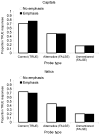What happened (and what didn't): Discourse constraints on encoding of plausible alternatives
- PMID: 24014934
- PMCID: PMC3763865
- DOI: 10.1016/j.jml.2013.06.003
What happened (and what didn't): Discourse constraints on encoding of plausible alternatives
Abstract
Three experiments investigated how font emphasis influences reading and remembering discourse. Although past work suggests that contrastive pitch contours benefit memory by promoting encoding of salient alternatives, it is unclear both whether this effect generalizes to other forms of linguistic prominence and how the set of alternatives is constrained. Participants read discourses in which some true propositions had salient alternatives (e.g., British scientists found the endangered monkey when the discourse also mentioned French scientists) and completed a recognition memory test. In Experiments 1 and 2, font emphasis in the initial presentation increased participants' ability to later reject false statements about salient alternatives but not about unmentioned items (e.g., Portuguese scientists). In Experiment 3, font emphasis helped reject false statements about plausible alternatives, but not about less plausible alternatives that were nevertheless established in the discourse. These results suggest readers encode a narrow set of only those alternatives plausible in the particular discourse. They also indicate that multiple manipulations of linguistic prominence, not just prosody, can lead to consideration of alternatives.
Keywords: alternative sets; discourse; fonts; reading; recognition memory.
Figures





Similar articles
-
Priming Effects of Focus in Mandarin Chinese.Front Psychol. 2019 Aug 30;10:1985. doi: 10.3389/fpsyg.2019.01985. eCollection 2019. Front Psychol. 2019. PMID: 31543850 Free PMC article.
-
Mapping Pitch Accents to Memory Representations in Spoken Discourse Among Chinese Learners of English: Effects of L2 Proficiency and Working Memory.Front Psychol. 2022 May 19;13:870152. doi: 10.3389/fpsyg.2022.870152. eCollection 2022. Front Psychol. 2022. PMID: 35664143 Free PMC article.
-
Recognition memory reveals just how CONTRASTIVE contrastive accenting really is.J Mem Lang. 2010 Oct 1;63(3):367-386. doi: 10.1016/j.jml.2010.06.004. J Mem Lang. 2010. PMID: 20835405 Free PMC article.
-
Focus Effects on Immediate and Delayed Recognition of Referents in Samoan.Lang Speech. 2023 Mar;66(1):175-201. doi: 10.1177/00238309221101396. Epub 2022 May 31. Lang Speech. 2023. PMID: 35638438
-
Verification of statements about story worlds that deviate from normal conceptions of time: what is true about Einstein's Dreams?Cogn Psychol. 1998 Apr;35(3):246-301. doi: 10.1006/cogp.1998.0680. Cogn Psychol. 1998. PMID: 9628746 Review.
Cited by
-
The influences of valence and arousal on judgments of learning and on recall.Mem Cognit. 2017 Jan;45(1):121-136. doi: 10.3758/s13421-016-0646-3. Mem Cognit. 2017. PMID: 27527533
-
Eye see what you're saying: Contrastive use of beat gesture and pitch accent affects online interpretation of spoken discourse.J Exp Psychol Learn Mem Cogn. 2021 Sep;47(9):1494-1526. doi: 10.1037/xlm0000986. Epub 2021 Feb 4. J Exp Psychol Learn Mem Cogn. 2021. PMID: 33539164 Free PMC article.
-
Accents, Not Just Prosodic Boundaries, Influence Syntactic Attachment.Lang Speech. 2018 Jun;61(2):246-276. doi: 10.1177/0023830917712282. Epub 2017 Jul 7. Lang Speech. 2018. PMID: 28686067 Free PMC article.
-
Priming Effects of Focus in Mandarin Chinese.Front Psychol. 2019 Aug 30;10:1985. doi: 10.3389/fpsyg.2019.01985. eCollection 2019. Front Psychol. 2019. PMID: 31543850 Free PMC article.
-
A further specification of the effects of font emphasis on reading comprehension: Evidence from event-related potentials and neural oscillations.Mem Cognit. 2024 Jan;52(1):225-239. doi: 10.3758/s13421-023-01457-9. Epub 2023 Sep 15. Mem Cognit. 2024. PMID: 37715010
References
-
- Agresti A. An introduction to categorical data analysis. 2. Hoboken, NJ: John Wiley & Sons; 2007.
-
- Almor A, Eimas PD. Focus and noun phrase anaphors in spoken language comprehension. Language and Cognitive Processes. 2008;23:201–225. doi: 10.1080/01690960701330936. - DOI
-
- Baayen RH. Analyzing linguistic data: A practical introduction to statistics. Cambridge University Press; 2008.
-
- Baayen RH, Davidson DJ, Bates DM. Mixed-effects modeling with crossed random effects for subjects and items. Journal of Memory and Language. 2008;59:390–412. doi: 10.1016/jmla.2007.12.005. - DOI
-
- Bates D, Maechler M, Bolker B. lme4: Linear mixed-effects models using S4 classes. R package version 0.99375-39. 2011 Retrieved from http://CRAN.R-project.org/package-lme4.
Grants and funding
LinkOut - more resources
Full Text Sources
Other Literature Sources
Miscellaneous
